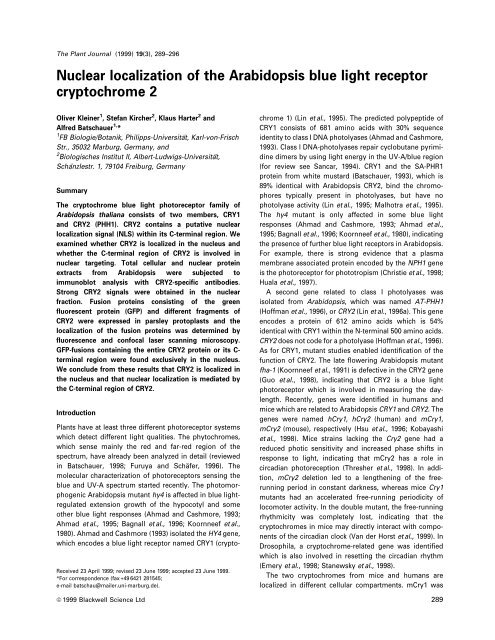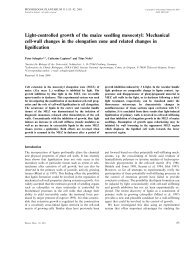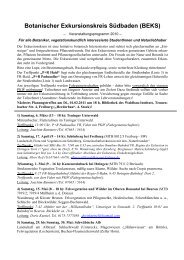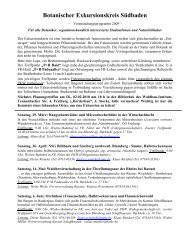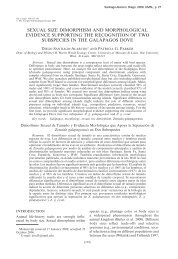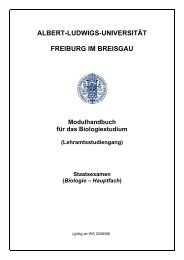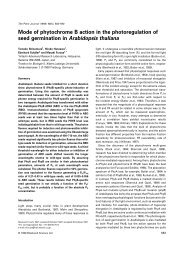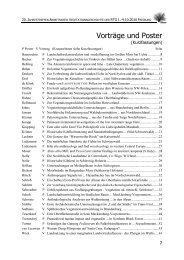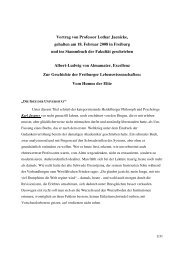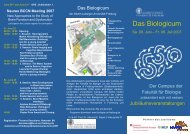Nuclear localization of the Arabidopsis blue light receptor ...
Nuclear localization of the Arabidopsis blue light receptor ...
Nuclear localization of the Arabidopsis blue light receptor ...
You also want an ePaper? Increase the reach of your titles
YUMPU automatically turns print PDFs into web optimized ePapers that Google loves.
The Plant Journal (1999) 19(3), 289±296<br />
<strong>Nuclear</strong> <strong>localization</strong> <strong>of</strong> <strong>the</strong> <strong>Arabidopsis</strong> <strong>blue</strong> <strong>light</strong> <strong>receptor</strong><br />
cryptochrome 2<br />
Oliver Kleiner 1 , Stefan Kircher 2 , Klaus Harter 2 and<br />
Alfred Batschauer 1, *<br />
1<br />
FB Biologie/Botanik, Philipps-UniversitaÈt, Karl-von-Frisch<br />
Str., 35032 Marburg, Germany, and<br />
2<br />
Biologisches Institut II, Albert-Ludwigs-UniversitaÈt,<br />
SchaÈnzlestr. 1, 79104 Freiburg, Germany<br />
Summary<br />
The cryptochrome <strong>blue</strong> <strong>light</strong> photo<strong>receptor</strong> family <strong>of</strong><br />
<strong>Arabidopsis</strong> thaliana consists <strong>of</strong> two members, CRY1<br />
and CRY2 (PHH1). CRY2 contains a putative nuclear<br />
<strong>localization</strong> signal (NLS) within its C-terminal region. We<br />
examined whe<strong>the</strong>r CRY2 is localized in <strong>the</strong> nucleus and<br />
whe<strong>the</strong>r <strong>the</strong> C-terminal region <strong>of</strong> CRY2 is involved in<br />
nuclear targeting. Total cellular and nuclear protein<br />
extracts from <strong>Arabidopsis</strong> were subjected to<br />
immunoblot analysis with CRY2-speci®c antibodies.<br />
Strong CRY2 signals were obtained in <strong>the</strong> nuclear<br />
fraction. Fusion proteins consisting <strong>of</strong> <strong>the</strong> green<br />
¯uorescent protein (GFP) and different fragments <strong>of</strong><br />
CRY2 were expressed in parsley protoplasts and <strong>the</strong><br />
<strong>localization</strong> <strong>of</strong> <strong>the</strong> fusion proteins was determined by<br />
¯uorescence and confocal laser scanning microscopy.<br />
GFP-fusions containing <strong>the</strong> entire CRY2 protein or its Cterminal<br />
region were found exclusively in <strong>the</strong> nucleus.<br />
We conclude from <strong>the</strong>se results that CRY2 is localized in<br />
<strong>the</strong> nucleus and that nuclear <strong>localization</strong> is mediated by<br />
<strong>the</strong> C-terminal region <strong>of</strong> CRY2.<br />
Introduction<br />
Plants have at least three different photo<strong>receptor</strong> systems<br />
which detect different <strong>light</strong> qualities. The phytochromes,<br />
which sense mainly <strong>the</strong> red and far-red region <strong>of</strong> <strong>the</strong><br />
spectrum, have already been analyzed in detail (reviewed<br />
in Batschauer, 1998; Furuya and SchaÈ fer, 1996). The<br />
molecular characterization <strong>of</strong> photo<strong>receptor</strong>s sensing <strong>the</strong><br />
<strong>blue</strong> and UV-A spectrum started recently. The photomorphogenic<br />
<strong>Arabidopsis</strong> mutant hy4 is affected in <strong>blue</strong> <strong>light</strong>regulated<br />
extension growth <strong>of</strong> <strong>the</strong> hypocotyl and some<br />
o<strong>the</strong>r <strong>blue</strong> <strong>light</strong> responses (Ahmad and Cashmore, 1993;<br />
Ahmad et al., 1995; Bagnall et al., 1996; Koornneef et al.,<br />
1980). Ahmad and Cashmore (1993) isolated <strong>the</strong> HY4 gene,<br />
which encodes a <strong>blue</strong> <strong>light</strong> <strong>receptor</strong> named CRY1 (crypto-<br />
Received 23 April 1999; revised 23 June 1999; accepted 23 June 1999.<br />
*For correspondence (fax +49 6421 281545;<br />
e-mail batschau@mailer.uni-marburg.de).<br />
chrome 1) (Lin et al., 1995). The predicted polypeptide <strong>of</strong><br />
CRY1 consists <strong>of</strong> 681 amino acids with 30% sequence<br />
identity to class I DNA photolyases (Ahmad and Cashmore,<br />
1993). Class I DNA-photolyases repair cyclobutane pyrimidine<br />
dimers by using <strong>light</strong> energy in <strong>the</strong> UV-A/<strong>blue</strong> region<br />
(for review see Sancar, 1994). CRY1 and <strong>the</strong> SA-PHR1<br />
protein from white mustard (Batschauer, 1993), which is<br />
89% identical with <strong>Arabidopsis</strong> CRY2, bind <strong>the</strong> chromophores<br />
typically present in photolyases, but have no<br />
photolyase activity (Lin et al., 1995; Malhotra et al., 1995).<br />
The hy4 mutant is only affected in some <strong>blue</strong> <strong>light</strong><br />
responses (Ahmad and Cashmore, 1993; Ahmad et al.,<br />
1995; Bagnall et al., 1996; Koornneef et al., 1980), indicating<br />
<strong>the</strong> presence <strong>of</strong> fur<strong>the</strong>r <strong>blue</strong> <strong>light</strong> <strong>receptor</strong>s in <strong>Arabidopsis</strong>.<br />
For example, <strong>the</strong>re is strong evidence that a plasma<br />
membrane associated protein encoded by <strong>the</strong> NPH1 gene<br />
is <strong>the</strong> photo<strong>receptor</strong> for phototropism (Christie et al., 1998;<br />
Huala et al., 1997).<br />
A second gene related to class I photolyases was<br />
isolated from <strong>Arabidopsis</strong>, which was named AT-PHH1<br />
(H<strong>of</strong>fman et al., 1996), or CRY2 (Lin et al., 1996a). This gene<br />
encodes a protein <strong>of</strong> 612 amino acids which is 54%<br />
identical with CRY1 within <strong>the</strong> N-terminal 500 amino acids.<br />
CRY2 does not code for a photolyase (H<strong>of</strong>fman et al., 1996).<br />
As for CRY1, mutant studies enabled identi®cation <strong>of</strong> <strong>the</strong><br />
function <strong>of</strong> CRY2. The late ¯owering <strong>Arabidopsis</strong> mutant<br />
fha-1 (Koornneef et al., 1991) is defective in <strong>the</strong> CRY2 gene<br />
(Guo et al., 1998), indicating that CRY2 is a <strong>blue</strong> <strong>light</strong><br />
photo<strong>receptor</strong> which is involved in measuring <strong>the</strong> daylength.<br />
Recently, genes were identi®ed in humans and<br />
mice which are related to <strong>Arabidopsis</strong> CRY1 and CRY2. The<br />
genes were named hCry1, hCry2 (human) and mCry1,<br />
mCry2 (mouse), respectively (Hsu et al., 1996; Kobayashi<br />
et al., 1998). Mice strains lacking <strong>the</strong> Cry2 gene had a<br />
reduced photic sensitivity and increased phase shifts in<br />
response to <strong>light</strong>, indicating that mCry2 has a role in<br />
circadian photoreception (Thresher et al., 1998). In addition,<br />
mCry2 deletion led to a leng<strong>the</strong>ning <strong>of</strong> <strong>the</strong> freerunning<br />
period in constant darkness, whereas mice Cry1<br />
mutants had an accelerated free-running periodicity <strong>of</strong><br />
locomoter activity. In <strong>the</strong> double mutant, <strong>the</strong> free-running<br />
rhythmicity was completely lost, indicating that <strong>the</strong><br />
cryptochromes in mice may directly interact with components<br />
<strong>of</strong> <strong>the</strong> circadian clock (Van der Horst et al., 1999). In<br />
Drosophila, a cryptochrome-related gene was identi®ed<br />
which is also involved in resetting <strong>the</strong> circadian rhythm<br />
(Emery et al., 1998; Stanewsky et al., 1998).<br />
The two cryptochromes from mice and humans are<br />
localized in different cellular compartments. mCry1 was<br />
ã 1999 Blackwell Science Ltd 289
290 Oliver Kleiner et al.<br />
found in <strong>the</strong> mitochondria, whereas most <strong>of</strong> <strong>the</strong> mCry2<br />
was located in <strong>the</strong> nucleus (Kobayashi et al., 1998). In line<br />
with <strong>the</strong> immuno-<strong>localization</strong> <strong>of</strong> mCry2, an hCry2±GFP<br />
fusion protein was targeted to <strong>the</strong> nucleus (Thresher et al.,<br />
1998). <strong>Arabidopsis</strong> CRY1 was found to be a soluble protein<br />
(Lin et al., 1996b), but was also found to be enriched in <strong>the</strong><br />
membrane fraction (Ahmad et al., 1998a). Very recently it<br />
was shown that a fusion protein consisting <strong>of</strong> <strong>Arabidopsis</strong><br />
CRY1 and GFP localizes to <strong>the</strong> nucleus on transient<br />
expression in onion epidermal cells, indicating that<br />
<strong>Arabidopsis</strong> CRY1 is a nuclear protein (Cashmore et al.,<br />
1999).<br />
Here we demonstrate, by <strong>the</strong> use <strong>of</strong> antibodies speci®c<br />
for CRY2, that <strong>Arabidopsis</strong> CRY2 is localized in <strong>the</strong> nucleus,<br />
as is mCry2 and hCry2. Thus, nuclear <strong>localization</strong> <strong>of</strong> CRY2<br />
is evolutionarily conserved in plants and animals. In order<br />
to identify <strong>the</strong> domain responsible for nuclear targeting,<br />
GFP was fused with de®ned regions <strong>of</strong> CRY2. The Cterminal<br />
extension <strong>of</strong> CRY2, which contains one bipartite<br />
NLS, is suf®cient for nuclear targeting.<br />
Results<br />
Antibodies speci®c for CRY2<br />
<strong>Arabidopsis</strong> CRY1 and CRY2 are well conserved within<br />
<strong>the</strong> N-terminal region (amino acid positions 1±500),<br />
sharing 54% identity. In contrast, <strong>the</strong> C-terminal regions<br />
<strong>of</strong> CRY1 and CRY2 differ in length and in sequence,<br />
except for a short serine-rich stretch (H<strong>of</strong>fman et al.,<br />
1996). In Escherichia coli cells we expressed <strong>the</strong> Cterminal<br />
region (amino acid position 501±612) <strong>of</strong> CRY2<br />
as a His±Taq fusion protein and puri®ed <strong>the</strong> protein by<br />
Ni-NTA chromatography. The puri®ed protein was used<br />
to raise antibodies in rabbits (see Experimental procedures).<br />
The antiserum was tested for speci®c recognition<br />
<strong>of</strong> CRY2 in protein gel blot analysis. Total protein<br />
extracts were isolated from dark-adapted <strong>Arabidopsis</strong><br />
wild-type (Ler), <strong>the</strong> cry2 mutant fha-1, and <strong>blue</strong> <strong>light</strong>treated<br />
wild-type (Ler) seedlings. fha-1 has a stop codon<br />
in <strong>the</strong> CRY2 gene and does not accumulate CRY2<br />
protein (Guo et al., 1998). Blue <strong>light</strong> treatment leads to<br />
a fast and strong decrease in <strong>the</strong> CRY2 protein level<br />
(Ahmad et al., 1998b; Guo et al., 1998; Lin et al., 1998),<br />
whereas CRY1 is <strong>light</strong>-stable (Lin et al., 1996b). Thus,<br />
one would expect that <strong>the</strong> CRY2-speci®c antiserum<br />
should only give a signal with extracts <strong>of</strong> dark-adapted<br />
wild-type seedlings and not with <strong>blue</strong> <strong>light</strong>-treated<br />
seedlings and <strong>the</strong> fha-1 mutant. Exactly this result was<br />
observed (Figure 1), demonstrating that <strong>the</strong> antiserum is<br />
speci®c for CRY2. The protein detected by <strong>the</strong> anti-CRY2<br />
antiserum has an apparent molecular mass in <strong>the</strong> range<br />
<strong>of</strong> 75±80 kDa, which is somewhat higher than <strong>the</strong><br />
calculated molecular mass <strong>of</strong> CRY2 (69.9 kDa).<br />
Figure 1. Characterization <strong>of</strong> antibodies speci®c for <strong>Arabidopsis</strong> CRY2.<br />
Protein gel blot analysis performed with total protein extracts from 6days-old<br />
<strong>Arabidopsis</strong> seedlings which have ei<strong>the</strong>r been dark adapted for<br />
72 h (dark) or kept in <strong>blue</strong> <strong>light</strong> for 24 h (<strong>blue</strong>) before harvest. Dark<br />
adapted <strong>Arabidopsis</strong> Landsberg erecta wild-type (Ler dark), <strong>blue</strong> <strong>light</strong>treated<br />
Landsberg erecta wild-type (Ler <strong>blue</strong>), dark adapted fha-1 mutant<br />
(fha-1 dark). Per lane 50 mg <strong>of</strong> protein were loaded and probed with <strong>the</strong><br />
antiserum raised against <strong>the</strong> C-terminal region <strong>of</strong> CRY2 (a). The blot was<br />
stripped and reprobed with antibodies against DnaK (b) as a control for<br />
equal loading and transfer. The arrow indicates <strong>the</strong> CRY2 signal.<br />
Molecular masses <strong>of</strong> standard proteins are indicated.<br />
<strong>Nuclear</strong> <strong>localization</strong> <strong>of</strong> CRY2<br />
As outlined above, <strong>Arabidopsis</strong> CRY1 and CRY2 share high<br />
similarity in <strong>the</strong> N-terminal region between amino acids 1±<br />
500. In contrast, <strong>the</strong> C-terminal regions <strong>of</strong> CRY1 and CRY2<br />
are not well conserved. By database searching we<br />
ã Blackwell Science Ltd, The Plant Journal, (1999), 19, 289±296
Figure 2. Putative nuclear <strong>localization</strong> signal <strong>of</strong> CRY2.<br />
The amino acid sequence <strong>of</strong> <strong>Arabidopsis</strong> thaliana CRY2 (positions 541±<br />
558) is shown in an alignment with <strong>the</strong> bipartite NLS <strong>of</strong> nuclear localized<br />
proteins. Basic amino acids are shown in bold. The bipartite motif is<br />
boxed in.<br />
identi®ed in <strong>the</strong> C-terminal region <strong>of</strong> CRY2 a nuclear<br />
<strong>localization</strong> sequence (NLS; amino acid positions 541±558),<br />
which belongs to <strong>the</strong> group <strong>of</strong> bipartite NLS (Figure 2). The<br />
CRY2 NLS is very similar to NLS <strong>of</strong> proteins, for which<br />
nuclear <strong>localization</strong> has already been demonstrated<br />
(GoÈ rlich and Mattaj, 1996; Kobayashi et al., 1998;<br />
Thresher et al., 1998).<br />
Due to <strong>the</strong> presence <strong>of</strong> an NLS in CRY2 we reasoned that<br />
CRY2 could be located in <strong>the</strong> nucleus. Therefore, we tested<br />
<strong>the</strong> cellular <strong>localization</strong> <strong>of</strong> CRY2 by immunological methods.<br />
Total cellular and nuclear protein extracts were<br />
isolated from <strong>Arabidopsis</strong> seedlings which were darkadapted<br />
for 72 h (see Experimental procedures). Fifty<br />
micrograms <strong>of</strong> total cellular proteins and 5 mg <strong>of</strong> nuclear<br />
proteins were separated by SDS-PAGE and probed in<br />
protein gel blot analysis. The purity <strong>of</strong> <strong>the</strong> nuclear fraction<br />
was tested with antibodies against nuclear (histone),<br />
cytosolic (HSC70) and mitochondrial (DnaK) proteins. The<br />
nuclear fraction gave signals with <strong>the</strong> anti-histone antibody<br />
but no signals with <strong>the</strong> anti-HSC70 and anti-DnaK<br />
antibodies (Figure 3), demonstrating that <strong>the</strong> nuclear<br />
fraction was not contaminated by proteins from o<strong>the</strong>r<br />
cellular compartments. Protein gel blot analysis using <strong>the</strong><br />
CRY2-speci®c antibody gave a single signal with <strong>the</strong> total<br />
cellular protein extract (Figure 3). In <strong>the</strong> nuclear fraction we<br />
also detected a single band with <strong>the</strong> CRY2-speci®c antibody.<br />
This band was more diffuse than in <strong>the</strong> total cellular<br />
extract and <strong>of</strong> a s<strong>light</strong>ly higher mobility. We assume that<br />
this was caused by some degradation <strong>of</strong> CRY2 during <strong>the</strong><br />
isolation <strong>of</strong> nuclei, although protease inhibitors were<br />
present during <strong>the</strong> whole procedure. The intensity <strong>of</strong> <strong>the</strong><br />
signal in <strong>the</strong> nuclear fraction was at least <strong>the</strong> same as in<br />
<strong>the</strong> total cellular protein fraction, though only one-tenth <strong>of</strong><br />
<strong>the</strong> amount <strong>of</strong> protein was loaded (Figure 3). We conclude<br />
from <strong>the</strong>se data that CRY2 is located in <strong>the</strong> nucleus.<br />
ã Blackwell Science Ltd, The Plant Journal, (1999), 19, 289±296<br />
<strong>Nuclear</strong> <strong>localization</strong> <strong>of</strong> CRY2 291<br />
Figure 3. Immunoblot detection <strong>of</strong> CRY2 in nuclear extracts.<br />
Fifty micrograms <strong>of</strong> total cellular (total) and 5 mg <strong>of</strong> nuclear (nuclear)<br />
protein extract were analyzed by immunoblotting with antibodies against<br />
CRY2 (Anti-CRY2). The blot was stripped and reprobed with antibodies<br />
against histone H2A/H2B (Anti-H2A/2B), HSC70 (Anti-HSC70) and DnaK<br />
(Anti-DnaK) as controls for nuclear, cytosolic and mitochondrial proteins,<br />
respectively.<br />
The C-terminal domain <strong>of</strong> CRY2 mediates nuclear<br />
<strong>localization</strong><br />
The data obtained with CRY2-speci®c antibodies demonstrated<br />
that CRY2 is localized in <strong>the</strong> nucleus. In order to<br />
de®ne <strong>the</strong> region <strong>of</strong> CRY2 which is responsible for nuclear<br />
targeting, we constructed fusion proteins <strong>of</strong> <strong>the</strong> green<br />
¯uorescent protein (GFP) and three different regions <strong>of</strong><br />
CRY2 (Figure 4). The gene constructs were introduced into<br />
parsley protoplasts, expressed, and <strong>the</strong> <strong>localization</strong> <strong>of</strong> <strong>the</strong><br />
chimeric GFP-proteins was studied by ¯uorescence and<br />
confocal laser scanning microscopy. The full-length CRY2±<br />
GFP fusion protein was found exclusively in <strong>the</strong> nucleus<br />
(Figure 4), con®rming <strong>the</strong> results obtained by protein gel<br />
blot analysis. In <strong>the</strong> case where <strong>the</strong> putative NLS located in<br />
CRY2 between amino acid positions 541 and 558 (Figure 2)<br />
is functional in nuclear targeting, one would expect that<br />
<strong>the</strong> fusion protein consisting <strong>of</strong> GFP and <strong>the</strong> C-terminal<br />
region <strong>of</strong> CRY2 would be located in <strong>the</strong> nucleus, and this<br />
was indeed observed (Figure 4). Since <strong>the</strong> fusion protein <strong>of</strong><br />
GFP with <strong>the</strong> N-terminal region <strong>of</strong> CRY2 was detected in<br />
<strong>the</strong> cytoplasm (Figure 4), we conclude that <strong>the</strong> C-terminal<br />
region is necessary and suf®cient for nuclear targeting <strong>of</strong><br />
CRY2.
292 Oliver Kleiner et al.<br />
Discussion<br />
We have analyzed <strong>the</strong> cellular <strong>localization</strong> <strong>of</strong> CRY2 by two<br />
different approaches. First, CRY2-speci®c antibodies gave<br />
signals only with one protein <strong>of</strong> <strong>the</strong> expected size in <strong>the</strong><br />
nuclear fraction. Second, <strong>the</strong> CRY2-GFP fusion protein was<br />
found exclusively in <strong>the</strong> nucleus. Therefore, <strong>Arabidopsis</strong><br />
CRY2 is obviously a nuclear protein.<br />
Figure 4. Localization <strong>of</strong> CRY2-GFP fusion<br />
proteins in parsley protoplasts.<br />
Shown are epi¯uorescence (left), <strong>light</strong><br />
microscopical images (middle) and confocal<br />
sections (right) <strong>of</strong> parsley protoplasts<br />
transiently expressing fusion proteins <strong>of</strong><br />
mGFP4 with full-length CRY2 (CRY2(1±612)/<br />
GFP), <strong>the</strong> N-terminal part <strong>of</strong> CRY2 (CRY2(1±<br />
500)/GFP) or <strong>the</strong> C-terminal part <strong>of</strong> CRY2<br />
(CRY2(501±612)/GFP). After transformation<br />
by electroporation <strong>the</strong> protoplasts were kept<br />
for 24 h in darkness. The left and middle<br />
panels show identical protoplasts. The GFP<br />
¯uorescence <strong>of</strong> confocal sections is<br />
presented in red. Arrows indicate <strong>the</strong><br />
position <strong>of</strong> nuclei.<br />
The GFP approach also enabled us to test which part <strong>of</strong><br />
CRY2 mediates nuclear targeting. Since <strong>the</strong> fusion protein<br />
<strong>of</strong> GFP with <strong>the</strong> C-terminal region <strong>of</strong> CRY2 was found<br />
exclusively in <strong>the</strong> nucleus, we assume that <strong>the</strong> bipartite<br />
NLS in <strong>the</strong> C-terminal region is responsible for <strong>the</strong> nuclear<br />
targeting <strong>of</strong> CRY2. The chromophore-binding domain is<br />
lacking in <strong>the</strong> C-terminal CRY2-GFP fusion protein. We<br />
ã Blackwell Science Ltd, The Plant Journal, (1999), 19, 289±296
conclude <strong>the</strong>refore that <strong>the</strong>re is no need for <strong>the</strong> presence <strong>of</strong><br />
chromophores for <strong>the</strong> nuclear import <strong>of</strong> CRY2.<br />
Fur<strong>the</strong>rmore, import occurs in darkness and seems not<br />
to be controlled by <strong>light</strong>.<br />
Genes were identi®ed in humans and mice, which are<br />
related in sequence to <strong>Arabidopsis</strong> CRY1 and CRY2 (Hsu<br />
et al., 1996; Kobayashi et al., 1998; Todo et al., 1996; Van<br />
der Spek et al., 1996). None <strong>of</strong> <strong>the</strong>se genes encode<br />
photolyase and it was suggested that <strong>the</strong>y could have a<br />
<strong>blue</strong> <strong>light</strong> <strong>receptor</strong> function (Hsu et al., 1996). Mice mutated<br />
in Cry2 showed an increased phase shift in circadian<br />
rhythm in response to <strong>light</strong> pulses. In addition, <strong>the</strong> freerunning<br />
period was extended, indicating that mCry2 is a<br />
photo<strong>receptor</strong> which entrains <strong>the</strong> endogenous oscillator<br />
and interacts with components <strong>of</strong> <strong>the</strong> circadian clock<br />
(Thresher et al., 1998). The <strong>Arabidopsis</strong> cry2 mutant is<br />
delayed in ¯owering under long-day conditions compared<br />
to <strong>the</strong> wild type (Guo et al., 1998). Therefore, <strong>Arabidopsis</strong><br />
CRY2 seems to have a similar function in <strong>the</strong> entrainment<br />
<strong>of</strong> <strong>the</strong> circadian clock as <strong>the</strong> animal cryptochromes. The<br />
fact that related proteins, which have <strong>blue</strong> <strong>light</strong> photo<strong>receptor</strong><br />
function, synchronize circadian rhythms in organisms<br />
as distantly related as plants and mammals is very<br />
interesting from an evolutionary point <strong>of</strong> view.<br />
Fur<strong>the</strong>rmore, results presented here which demonstrate<br />
that <strong>Arabidopsis</strong> CRY2 is localized within <strong>the</strong> nucleus as is<br />
Cry2 in mice and humans (Kobayashi et al., 1998; Thresher<br />
et al., 1998) may well be very important for <strong>the</strong> fur<strong>the</strong>r<br />
understanding <strong>of</strong> <strong>the</strong> molecular mechanism by which <strong>the</strong><br />
<strong>light</strong> signal is transduced to <strong>the</strong> clock. Studies on <strong>the</strong><br />
circadian rhythm <strong>of</strong> cab gene transcription in photo<strong>receptor</strong><br />
mutants demonstrate that besides cryptochromes,<br />
phytochromes also entrain <strong>the</strong> circadian clock (Somers<br />
et al., 1998). At least one member <strong>of</strong> <strong>the</strong> phytochrome<br />
family (phytochrome B) is also nuclear localized<br />
(Sakamoto and Nagatani, 1996) and <strong>the</strong> accumulation <strong>of</strong><br />
phyB in <strong>the</strong> nucleus is induced by red <strong>light</strong> (Yamaguchi<br />
et al., 1999). Phytochrome B seems to have an antagonistic<br />
role to CRY2 in ¯ower induction. Whereas <strong>the</strong> cry2 mutant<br />
is delayed in ¯owering, <strong>the</strong> phyB mutant ¯owers earlier<br />
(Guo et al., 1998).<br />
How <strong>the</strong> different photo<strong>receptor</strong>s act toge<strong>the</strong>r is still<br />
poorly understood. Recently, direct molecular interaction<br />
between PhyA and CRY1 in <strong>the</strong> yeast two-hybrid system<br />
has been demonstrated (Ahmad et al., 1998c). If CRY2<br />
would physically interact with ano<strong>the</strong>r photo<strong>receptor</strong>,<br />
PhyB would be a good candidate since both photo<strong>receptor</strong>s<br />
are located in <strong>the</strong> nucleus. However, phyB is <strong>light</strong>stable<br />
and operates under low and high intensity (red)<br />
<strong>light</strong> conditions (for review see Batschauer, 1998; Furuya<br />
and SchaÈ fer, 1996), whereas CRY2 disappears under high<br />
intensity (<strong>blue</strong>) <strong>light</strong> conditions (Ahmad et al., 1998b; Lin<br />
et al., 1998). CRY1 is <strong>light</strong>-stable (Ahmad et al., 1998b; Lin<br />
et al., 1996b), whereas PhyA rapidly disappears under low<br />
ã Blackwell Science Ltd, The Plant Journal, (1999), 19, 289±296<br />
and high intensity (red) <strong>light</strong> conditions (for review see<br />
Batschauer, 1998; Furuya and SchaÈ fer, 1996). Models for<br />
<strong>the</strong> molecular interaction <strong>of</strong> photo<strong>receptor</strong>s must <strong>the</strong>refore<br />
consider <strong>the</strong> effects <strong>of</strong> <strong>light</strong> on photo<strong>receptor</strong> stability as<br />
well as on <strong>the</strong> cellular <strong>localization</strong> <strong>of</strong> <strong>the</strong> photo<strong>receptor</strong>s.<br />
The nuclear <strong>localization</strong> <strong>of</strong> CRY2 which we presented here<br />
may facilitate <strong>the</strong> identi®cation <strong>of</strong> interacting partners by<br />
focussing on those which are located in <strong>the</strong> nucleus.<br />
Experimental procedures<br />
Plant material, growth conditions and <strong>light</strong> treatment<br />
<strong>Arabidopsis</strong> thaliana ecotype Landsberg erecta (Ler) and <strong>the</strong> fha-1<br />
mutant (Koornneef et al., 1991), which has Ler background, were<br />
used. Plants were grown on four layers <strong>of</strong> Whatman paper soaked<br />
with distilled water in plastic containers. Germination was<br />
induced by a 24 h incubation at 4°C followed by white <strong>light</strong><br />
treatment for 1 h. Plants were kept at 25°C for 72 h in a 16 h/8 h<br />
<strong>light</strong>/dark cycle (<strong>light</strong> intensity 250 mmol m ±1 s ±1 ) in a growth<br />
chamber and dark-adapted afterwards for 72 h. In some experiments<br />
plant were treated with <strong>blue</strong> <strong>light</strong> (¯uence rate 4.1 W m ±2 )<br />
for 24 h before harvest, as described previously (Kaiser et al.,<br />
1995). All manipulations were carried out in orange-safe <strong>light</strong><br />
(Osram L36 W/62).<br />
Isolation <strong>of</strong> total cellular proteins<br />
Seedlings were quick-frozen and ground in liquid nitrogen. One<br />
hundred microlitres <strong>of</strong> SDS sample buffer (62.5 mM Tris±HCl<br />
pH 6.8, 4 M urea, 0.7 M b-mercaptoethanol, 2% (w/v) SDS, 0.002%<br />
(w/v) bromphenol <strong>blue</strong>, 10% glycerol) were added per mg <strong>of</strong> plant<br />
material. Samples were boiled for 10 min and clari®ed by<br />
centrifugation (20 000 g for 10 min).<br />
Isolation <strong>of</strong> nuclear proteins<br />
<strong>Nuclear</strong> <strong>localization</strong> <strong>of</strong> CRY2 293<br />
Twenty grams <strong>of</strong> <strong>the</strong> aerial part from <strong>Arabidopsis</strong> seedlings,<br />
which were dark-adapted for 72 h, were used for <strong>the</strong> preparation<br />
<strong>of</strong> nuclei according to a published procedure (Willmitzer and<br />
Wagner, 1981). During <strong>the</strong> whole procedure, <strong>the</strong> following<br />
protease inhibitors were present: AEBSF (1 mM), bestatin<br />
(10 mM), pepstatin A (1 mM), E-64 (10 mM), leupetin (100 mM), 1,10phenanthroline<br />
(100 mM). Nuclei were resuspended in SDSsample<br />
buffer, boiled for 10 min and clari®ed by centrifugation<br />
(20 000 g for 10 min).<br />
Transient transformation <strong>of</strong> protoplasts by<br />
electroporation<br />
For transient expression <strong>of</strong> GFP-constructs, protoplasts were<br />
prepared from a dark-grown parsley (Petroselinum crispum) cell<br />
culture 6 days after subculturing according to a published<br />
procedure (Dangl et al., 1987). Electroporation <strong>of</strong> protoplasts<br />
was performed in 0.4 cm cuvettes at 320 V and 125 mF (W®`,<br />
pulse time: 10 ms) using a Gene Pulser II (Biorad, Munich,<br />
Germany) at room temperature as described previously (Kircher<br />
et al., 1999). After electroporation, protoplasts were diluted in 5 ml<br />
HA-medium (Dangl et al., 1987) containing 0.4 M sucrose, transferred<br />
to Petri dishes and kept in darkness for 24 h.
294 Oliver Kleiner et al.<br />
Light, epi¯uorescence and confocal scanning microscopy<br />
For <strong>light</strong> and epi¯uorescence microscopy, 80 ml <strong>of</strong> protoplast<br />
suspensions were transferred to a glass slide and analyzed in an<br />
Axiovert microscope (Zeiss, Oberkochen, Germany). Excitation <strong>of</strong><br />
GFP was performed with standard FITC ®lters (Kircher et al., 1999).<br />
Documentation was done by photography with an automatic<br />
Contax 167 MT camera on Kodak 64T ®lm. Confocal laser<br />
scanning microscopy (DM RBE, Leica, Bensheim, Germany) was<br />
performed as described by Kircher et al. (1999).<br />
Expression <strong>of</strong> His±taq fusion protein and <strong>the</strong> production<br />
<strong>of</strong> a CRY2-speci®c antibody<br />
A63His±Taq fusion <strong>of</strong> <strong>the</strong> C-terminal region (amino acid 501±612)<br />
<strong>of</strong> CRY2 in <strong>the</strong> vector pQE-30 (Quiagen, Hilden, Germany) was<br />
expressed in E. coli M15[pREP4] cells (Quiagen, Hilden, Germany)<br />
at 37°C after induction with 1 mM IPTG. The fusion protein was<br />
puri®ed with an Ni-NTA column according to <strong>the</strong> manufacturer's<br />
protocol under denaturing conditions (Quiagen, Hilden,<br />
Germany). One milligram <strong>of</strong> <strong>the</strong> puri®ed protein was used for<br />
raising antiserum in a rabbit. The immunization was performed<br />
by Eurogentec (Searing, Belgium). The speci®city <strong>of</strong> <strong>the</strong> antiserum<br />
was tested using E. coli expressed CRY2. The limit <strong>of</strong><br />
detection in gel blot analysis was below 10 ng <strong>of</strong> protein (data<br />
not shown).<br />
SDS-PAGE and gel blot analysis<br />
Proteins were fractionated on 6% SDS-PAGE (SchaÈ gger and von<br />
Jagow, 1987) and blotted on PVDF membranes (Macherey-Nagel,<br />
DuÈ ren, Germany). The blot was blocked with 7% non-fat dry milk<br />
in TBST (20 mM Tris/HCl pH 7.5, 150 mM NaCl, 0.1% Tween-20) and<br />
incubated with anti-CRY2 antiserum (1 : 1000 dilution). The blot<br />
was <strong>the</strong>n incubated with <strong>the</strong> secondary antibody (donkey antirabbit<br />
IgG; Amersham-Pharmacia, Freiburg, Germany) conjugated<br />
with horseradish peroxidase (1: 10 000 dilution). After each<br />
incubation step with antibodies <strong>the</strong> blot was washed with TBST.<br />
Immunodetection was undertaken with <strong>the</strong> ECL-plus system<br />
(Amersham-Pharmacia, Freiburg, Germany) according to <strong>the</strong><br />
manufacturer's instructions. The same procedure was used for<br />
antibodies against (cytosolic) HSC70 (Neumann et al., 1989),<br />
histone H2A/ H2B (Mazzolini et al., 1989) and DnaK (Neumann<br />
et al., 1989). The anti-HSC70 antiserum was diluted 1 : 5000, <strong>the</strong><br />
anti-histone antiserum 1 : 1000 and <strong>the</strong> anti-DnaK antiserum<br />
1 : 1000. The molecular weight marker was SDS-7B (Sigma,<br />
Deisenh<strong>of</strong>en, Germany). Protein concentration was determined<br />
according to Popov et al. (1975).<br />
Gene construction<br />
Construct for E. coli expression. The region <strong>of</strong> CRY2, encoding<br />
amino acids 501±612 (CRY2(501±612)), was ampli®ed by PCR<br />
using <strong>the</strong> cDNA clone PHH1 (H<strong>of</strong>fman et al., 1996) as template.<br />
PCR was performed with a pro<strong>of</strong>-reading polymerase (Vent R q -<br />
polymerase, New England Biolabs, Schwalbach, Germany). The<br />
following primer combination was used: 5¢-GAGCTCATTGT-<br />
AGCAGATAGCTTCGAGGCC-3¢ (upstream primer), 5¢-GTCGAC-<br />
TTGGCAACCATTTTTTCCCAAACTTGT-3¢ (downstream primer).<br />
Restriction sites for SacI and SalI were introduced into <strong>the</strong><br />
upstream and downstream primer, respectively (underlined in<br />
<strong>the</strong> primer sequences). PCR products were subcloned into <strong>the</strong><br />
pCR q II-TOPO vector (Invitrogen, De Schelp, <strong>the</strong> Ne<strong>the</strong>rlands) after<br />
<strong>the</strong> addition <strong>of</strong> 3¢A-overhangs with Taq-polymerase post-ampli®cation.<br />
The resulting plasmids were cut with SacI and SalI to<br />
release <strong>the</strong> insert which was ligated into <strong>the</strong> SacI/SalI sites <strong>of</strong> <strong>the</strong><br />
E. coli expression vector pQE-30 (Quiagen, Hilden, Germany).<br />
GFP constructs. Three constructs containing <strong>the</strong> coding region<br />
<strong>of</strong> GFP and varying regions <strong>of</strong> CRY2 were made. Construct<br />
CRY2(1±612)/GFP contained <strong>the</strong> complete coding region <strong>of</strong> CRY2<br />
(comprising amino acids 1±612), construct CRY2(1±500)/GFP<br />
contained <strong>the</strong> N-terminal region <strong>of</strong> CRY2 (comprising amino<br />
acids 1±500), construct CRY2(501±612)/GFP contained <strong>the</strong> Cterminal<br />
region <strong>of</strong> CRY2 (comprising amino acids 501±612). The<br />
different regions <strong>of</strong> CRY2 were ampli®ed by PCR using VentR q -<br />
polymerase (New England Biolabs, Schwalbach, Germany) and<br />
<strong>the</strong> cDNA clone PHH1 (H<strong>of</strong>fman et al., 1996) as template. The<br />
following primer combinations were used. Construct CRY2(1±<br />
612)/GFP: 5¢ CCCGGGATGAAGATGGACAAAAAGACTATAGTT-3¢<br />
(upstream primer), 5¢-CCCGGGTTGGCAACCATTTTTTCCCAAAC-<br />
TTGT-3¢ (downstream primer). Construct CRY2(1±500)/GFP:<br />
5¢ CCCGGGATGAAGATGGACAAAAAGACTATAGTT-3¢ (upstream<br />
primer), 5¢-CCCGGGATCAGGTGCTGCTCCGATCATGATCTG-3¢<br />
(downstream primer). Construct CRY2(501±612)/GFP: 5¢ GGATCC-<br />
AACAATGGCAGATAGCTTCGAGGCCTTA-3¢ (upstream primer),<br />
5¢-CCCGGGTTGGCAACCATTTTTTCCCAAACTTGT-3¢ (downstream<br />
primer). Restriction sites for SmaI present in <strong>the</strong><br />
oligonucleotides except for <strong>the</strong> upstream primer <strong>of</strong> construct<br />
CRY2(501±612)/GFP are underlined. In <strong>the</strong> upstream primer for<br />
construct CRY2(501±612)/GFP a BamHI-site (underlined) and an<br />
optimized translation initiation signal (italics) around <strong>the</strong> start<br />
codon ATG (bold) were introduced. PCR products were subcloned<br />
into <strong>the</strong> pCR q II-TOPO vector (Invitrogen, De Schelp, <strong>the</strong><br />
Ne<strong>the</strong>rlands) after <strong>the</strong> addition <strong>of</strong> 3¢A-overhangs with Taqpolymerase<br />
post-ampli®cation. The resulting plasmids were cut<br />
with SmaI (constructs CRY2(1±612)/GFP and CRY2(1±500)/GFP) or<br />
with BamHI/SmaI (construct CRY2(501±612)/GFP) to release <strong>the</strong><br />
inserts which were ligated in frame with <strong>the</strong> coding region <strong>of</strong><br />
mGFP4 (Hasel<strong>of</strong>f et al., 1997) in <strong>the</strong> vector pMAV4 (Kircher et al.,<br />
1999). All constructs were checked by sequencing.<br />
Acknowledgements<br />
We thank Oxana Panajotow for excellent technical assistance and<br />
help in making <strong>the</strong> ®gures and Dr Helen Steele (University <strong>of</strong><br />
Marburg, Germany) for critical reading <strong>of</strong> <strong>the</strong> manuscript. We also<br />
thank Dr L. Nover (University <strong>of</strong> Frankfurt, Germany) for <strong>the</strong> gift <strong>of</strong><br />
antisera against HSC70 and DnaK and Dr G. Philipps (University <strong>of</strong><br />
Strasbourg, France) for <strong>the</strong> gift <strong>of</strong> antiserum against histone H2A/<br />
H2B. This research was funded by a grant from <strong>the</strong> Deutsche<br />
Forschungsgemeinschaft to A.B. (BA958/5±2) and from <strong>the</strong> Human<br />
Frontier Science Program to K.H. (RG0043/1997-M).<br />
References<br />
Ahmad, M. and Cashmore, A.R. (1993) HY4 gene <strong>of</strong> A. thaliana<br />
encodes a protein with characteristics <strong>of</strong> a <strong>blue</strong>-<strong>light</strong><br />
photo<strong>receptor</strong>. Nature, 366, 162±166.<br />
Ahmad, M., Jarillo, J.A., Smirnova, O. and Cashmore, A.R. (1998a)<br />
Cryptochrome <strong>blue</strong>-<strong>light</strong> photo<strong>receptor</strong>s <strong>of</strong> <strong>Arabidopsis</strong><br />
implicated in phototropism. Nature, 392, 720±723.<br />
Ahmad, M., Jarillo, J. and Cashmore, A.R. (1998b) Chimeric<br />
proteins between cry1 and cry2 <strong>Arabidopsis</strong> <strong>blue</strong> <strong>light</strong><br />
photo<strong>receptor</strong>s indicate overlapping functions and varying<br />
protein stability. Plant Cell, 10, 197±207.<br />
ã Blackwell Science Ltd, The Plant Journal, (1999), 19, 289±296
Ahmad, M., Jarillo, J.A., Smirnova, O. and Cashmore, A.R. (1998c)<br />
The CRY1 <strong>blue</strong> <strong>light</strong> photo<strong>receptor</strong> <strong>of</strong> <strong>Arabidopsis</strong> interacts with<br />
phytochrome A in vitro. Mol. Cell, 1, 939±948.<br />
Ahmad, M., Lin, C. and Cashmore, A.R. (1995) Mutations<br />
throughout an <strong>Arabidopsis</strong> <strong>blue</strong>-<strong>light</strong> photo<strong>receptor</strong> impair<br />
<strong>blue</strong>-<strong>light</strong>-responsive anthocyanin accumulation and<br />
inhibition <strong>of</strong> hypocotyl elongation. Plant J. 8, 653±658.<br />
Bagnall, D.J., King, R.W. and Hangarter, R.P. (1996) Blue <strong>light</strong><br />
promotion <strong>of</strong> ¯owering is absent in hy4 mutants <strong>of</strong><br />
<strong>Arabidopsis</strong>. Planta, 200, 278±280.<br />
Batschauer, A. (1993) A plant gene for photolyase: an enzyme<br />
catalyzing <strong>the</strong> repair <strong>of</strong> UV-<strong>light</strong>-induced DNA damage. Plant J.<br />
4, 705±709.<br />
Batschauer, A. (1998) Photo<strong>receptor</strong>s <strong>of</strong> higher plants. Planta, 206,<br />
479±492.<br />
Cashmore, A.R., Jarillo, J.A., Wu, Y.-J. and Liu, D. (1999)<br />
Cryptochromes: <strong>blue</strong> <strong>light</strong> <strong>receptor</strong>s for plants and animals.<br />
Science, 284, 760±765.<br />
Christie, J.M., Reymond, P., Powell, G.K., Bernasconi, P.,<br />
Raibekas, A.A., Liscum, E. and Briggs, W.R. (1998)<br />
<strong>Arabidopsis</strong> NPH1: a ¯avoprotein with <strong>the</strong> properties <strong>of</strong> a<br />
photo<strong>receptor</strong> for phototropism. Science, 282, 1698±1701.<br />
Dangl, J.L., Hauffe, S., Lipphardt, K., Hahlbrock, K. and Scheel, D.<br />
(1987) Parsley protoplasts retain differential responsiveness to<br />
UV <strong>light</strong> and fungal elicitor. EMBO J. 6, 2551±2556.<br />
Emery, P., So, W.V., Kaneko, M., Hall, J.C. and Rosbash, M. (1998)<br />
CRY, a Drosophila clock and <strong>light</strong>-regulated cryptochrome, is a<br />
major contributor to circadian rhythm resetting and<br />
photosensitivity. Cell, 95, 669±679.<br />
Furuya, M. and SchaÈ fer, E. (1996) Photoperception and signalling<br />
<strong>of</strong> induction reactions by different phytochromes. Trends Plant<br />
Sci. 1, 301±307.<br />
GoÈ rlich, D. and Mattaj, I.W. (1996) Nucleocytoplasmatic transport.<br />
Science, 271, 1513±1518.<br />
Guo, H., Yang, H., Mockler, T.C. and Lin, C. (1998) Regulation <strong>of</strong><br />
¯owering time by <strong>Arabidopsis</strong> photo<strong>receptor</strong>s. Science, 279,<br />
1360±1363.<br />
Hasel<strong>of</strong>f, J., Siemering, K.R., Prasher, D.C. and Hodge, S. (1997)<br />
Removal <strong>of</strong> a cryptic intron and subcellular <strong>localization</strong> <strong>of</strong> green<br />
¯uorescent protein are required to mark transgenic <strong>Arabidopsis</strong><br />
plants brightly. Proc. Natl Acad. Sci. USA, 94, 2122±2127.<br />
H<strong>of</strong>fman, P.D., Batschauer, A. and Hays, J.B. (1996) AT-PHH1, a<br />
novel gene from <strong>Arabidopsis</strong> thaliana related to microbial<br />
photolyases and plant <strong>blue</strong> <strong>light</strong> photo<strong>receptor</strong>s. Mol. Gen.<br />
Genet. 253, 259±265.<br />
Hsu, D.S., Zhao, X., Zhao, S., Kazatsev, A., Wang, R.P., Todo, T.,<br />
Wei, Y.F. and Sancar, A. (1996) Putative human <strong>blue</strong>-<strong>light</strong><br />
photo<strong>receptor</strong>s hCRY1 and hCRY2 are ¯avoproteins.<br />
Biochemistry, 35, 13871±13877.<br />
Huala, E., Oeller, P.W., Liscum, E., Han, I.-S., Larsen, E. and Briggs,<br />
W.R. (1997) <strong>Arabidopsis</strong> NPH1: a protein kinase with a putative<br />
redox-sensing domain. Science, 278, 2120±2123.<br />
Kaiser, T., Emmler, K., Kretsch, T., Weisshaar, B., SchaÈ fer, E. and<br />
Batschauer, A. (1995) Promoter elements <strong>of</strong> <strong>the</strong> mustard CHS1<br />
gene are suf®cient for <strong>light</strong> regulation in transgenic plants.<br />
Plant Mol. Biol. 28, 219±229.<br />
Kircher, S., Wellmer, F., Nick, P., RuÈ gner, A., SchaÈ fer, E. and<br />
Harter, K. (1999) <strong>Nuclear</strong> import <strong>of</strong> <strong>the</strong> parsley bZIP<br />
transcription factor CPRF2 is regulated by phytochrome<br />
photo<strong>receptor</strong>s. J. Cell Biol. 144, 201±211.<br />
Kobayashi, K., Kanno, S., Smit, B., van der Horst, G.T.J., Takao,<br />
M. and Yasui, A. (1998) Characterization <strong>of</strong> photolyase/<strong>blue</strong><strong>light</strong><br />
<strong>receptor</strong> homologs in mouse and human cells. Nucl. Acids<br />
Res. 26, 5086±5092.<br />
ã Blackwell Science Ltd, The Plant Journal, (1999), 19, 289±296<br />
<strong>Nuclear</strong> <strong>localization</strong> <strong>of</strong> CRY2 295<br />
Koornneef, M., Hanhart, C.J. and van der Veen, J.H. (1991) A<br />
genetic and physiological analysis <strong>of</strong> late ¯owering mutants in<br />
<strong>Arabidopsis</strong> thaliana. Mol. Gen. Genet. 229, 57±66.<br />
Koornneef, M., Rolff, E. and Spruit, C.J.P. (1980) Genetic control<br />
<strong>of</strong> <strong>light</strong>-inhibited hypocotyl elongation in <strong>Arabidopsis</strong> thaliana<br />
(L). HEYNH. Z. P¯anzenphysiol. 100, 147±160.<br />
Lin, C., Ahmad, M., Chan, J. and Cashmore, A.R. (1996a) CRY2: a<br />
second member <strong>of</strong> <strong>the</strong> <strong>Arabidopsis</strong> cryptochrome gene family.<br />
Plant Physiol. 110, 1047.<br />
Lin, C., Ahmad, M. and Cashmore, A.R. (1996b) <strong>Arabidopsis</strong><br />
cryptochrome 1 is a soluble protein mediating <strong>blue</strong> <strong>light</strong>dependent<br />
regulation <strong>of</strong> plant growth and development. Plant<br />
J. 10, 893±902.<br />
Lin, C., Robertson, D.E., Ahmad, M., Raibekas, A.A., Schuman<br />
Jornes, M., Dutton, P.L. and Cashmore, A. (1995) Association <strong>of</strong><br />
¯avin adenine dinucleotide with <strong>the</strong> <strong>Arabidopsis</strong> <strong>blue</strong> <strong>light</strong><br />
<strong>receptor</strong> CRY1. Science, 269, 968±970.<br />
Lin, C., Yang, H., Guo, H., Mockler, T., Chen, J. and Cashmore,<br />
A.R. (1998) Enhancement <strong>of</strong> <strong>blue</strong>-<strong>light</strong> sensitivity <strong>of</strong> <strong>Arabidopsis</strong><br />
seedlings by a <strong>blue</strong> <strong>light</strong> <strong>receptor</strong> cryptochrome 2. Proc. Natl<br />
Acad. Sci. USA, 95, 2686±2690.<br />
Malhotra, K., Kim, S.-T., Batschauer, A., Dawut, L. and Sancar, A.<br />
(1995) Putative <strong>blue</strong>-<strong>light</strong> photo<strong>receptor</strong>s from <strong>Arabidopsis</strong><br />
thaliana and Sinapis alba with high degree <strong>of</strong> sequence<br />
homology to DNA photolyase contain <strong>the</strong> two photolyase<br />
c<strong>of</strong>actors but lack DNA repair activity. Biochemistry, 34, 6892±<br />
6899.<br />
Mazzolini, L., Vaek, M. and van Montagu, M.V. (1989) Conserved<br />
epitopes on plant histones recognized by monoclonal<br />
antibodies. Eur. J. Biochem. 178, 779±787.<br />
Neumann, D., Nover, L., Parthier, B., Rieger, R., Scharf, K.,<br />
Wollgiehn, R. and zur Nieden, U. (1989) Heat shock and o<strong>the</strong>r<br />
stress response systems <strong>of</strong> plants. Biol. Zentralbl. 108, 1±156.<br />
Popov, N., Schmitt, S. and Matthies, H. (1975) Eine stoÈ rungsfreie<br />
Mikromethode zur Bestimmung des Proteingehalts in<br />
Gewebehomogenaten. Acta Biol. Germ. 34, 1441±1446.<br />
Sakamoto, K. and Nagatani, A. (1996) <strong>Nuclear</strong> <strong>localization</strong> activity<br />
<strong>of</strong> phytochrome B. Plant J. 10, 859±868.<br />
Sancar, A. (1994) Mechanisms <strong>of</strong> DNA excision repair. Science,<br />
266, 1954±1958.<br />
SchaÈ gger, H. and von Jagow, G. (1987) Tricine-sodium dodecyl<br />
sulfate-polyacrylamid gel electrophoresis for <strong>the</strong> separation <strong>of</strong><br />
proteins in <strong>the</strong> range from 1 to 100 kDa. Anal. Biochem. 166,<br />
368±379.<br />
Somers, D.E., Devlin, P.F. and Kay, S.A. (1998) Phytochromes and<br />
cryptochromes in <strong>the</strong> entrainment <strong>of</strong> <strong>the</strong> <strong>Arabidopsis</strong> circadian<br />
clock. Science, 20, 1488±1490.<br />
Stanewsky, R., Kaneko, M., Emery, P., Beretta, B., Wagner-Smith,<br />
K., Kay, S.A., Rosbash, M. and Hall, J.C. (1998) The cry b<br />
mutation identi®es cryptochrome as a circadian photo<strong>receptor</strong><br />
in Drosophila. Cell, 95, 681±692.<br />
Thresher, R.J., Vitaterna, M.H., Miyamoto, Y. et al. (1998) Role <strong>of</strong><br />
mouse cryptochrome <strong>blue</strong>-<strong>light</strong> photo<strong>receptor</strong> in circadian<br />
photoresponses. Science, 282, 1490±1494.<br />
Todo, T., Ryo, H., Yamamoto, K., Toh, H., Inui, T., Ayaki, H.,<br />
Nomura, T. and Ikenaga, M. (1996). Similarity among<br />
Drosophila (6±4) photolyase, a human photolyase homolog,<br />
and <strong>the</strong> DNA photolyase-<strong>blue</strong>-<strong>light</strong> photo<strong>receptor</strong> family.<br />
Science, 272, 109±112.<br />
Van der Horst, G.T.J., Muijtjens, M., Kobayashi, K. et al. (1999)<br />
Mammalian Cry1 and Cry2 are essential for maintenance <strong>of</strong><br />
circadian rhythms. Nature, 398, 627±630.<br />
Van der Spek, P.J., Kobayashi, K., Bootsma, D., Takao, M., Eker,<br />
A.P.M. and Yasui, A. (1996) Cloning, tissue expression, and
296 Oliver Kleiner et al.<br />
mapping <strong>of</strong> a human photolyase homolog with similarity to<br />
plant <strong>blue</strong>-<strong>light</strong> <strong>receptor</strong>s. Genomics, 37, 177±182.<br />
Willmitzer, L. and Wagner, K.G. (1981) The isolation <strong>of</strong> nuclei from<br />
tissue-cultured plant cells. Exp. Cell. Res. 135, 69±77.<br />
Note added in pro<strong>of</strong><br />
Yamaguchi, R., Nakamura, M., Mochizuki, N., Kay, S.A. and<br />
Nagatani, A. (1999) Light-dependent translocation <strong>of</strong> a<br />
phytochrome B-GFP fusion protein to <strong>the</strong> nucleus in<br />
transgenic <strong>Arabidopsis</strong>. J. Cell Biol. 145, 437±445.<br />
The paper The <strong>Arabidopsis</strong> <strong>blue</strong> <strong>light</strong> <strong>receptor</strong> cryptochrome 2 is a nuclear protein regulated by a <strong>blue</strong> <strong>light</strong>-dependent<br />
post-transcriptional mechanism by Hongwei Guo, Hien Duong, Nha Ma and Chentao Lin, which is based on independent<br />
research, reached <strong>the</strong> same conclusion as our work at <strong>the</strong> same time and is published on pages 279±287 in this issue <strong>of</strong><br />
The Plant Journal.<br />
ã Blackwell Science Ltd, The Plant Journal, (1999), 19, 289±296


